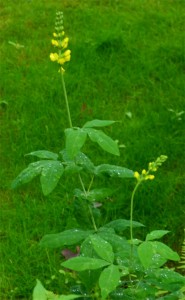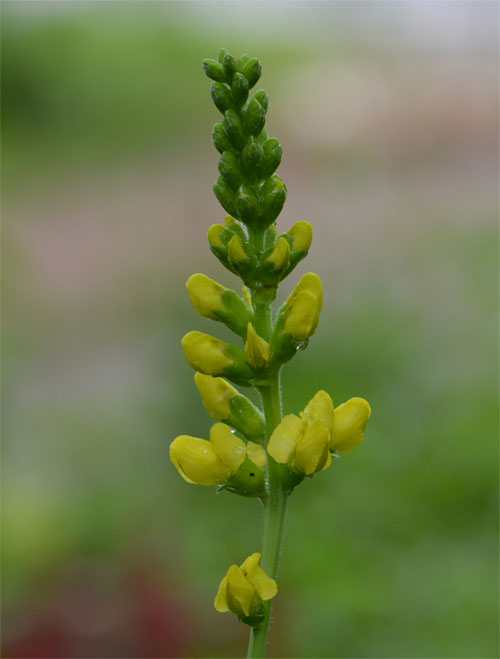 This plant was a total surprise addition to my garden. I had some Chelone glabra delivered last fall for a late fall planting, and somehow or other this plant made it into the mix. Probably the result of a pre-dawn or pre-coffee loading of the delivery truck. The plant is almost 5 feet tall and is now delivering beautiful yellow spikes. Thermopsis villosa normally thrives in sun and average soil – Where I have it located may be a bit shadier than the plant would like, but I will try to do better with its progeny – it should be fairly easy to collect the seeds. Flowers fade to long-lasting flat seed pods atop hairy stems. It is apparently quite easy to grow, and has a wide range of hardiness. It is native to the coastal eastern US states. Despite the name, botanically it is not a lupine at all. Native to the mountains of North Carolina, Thermopsis performs beautifully where true lupines can’t – mainly because of temperature and drought conditions. The clean compound foliage also (or so far) seems to be rabbit-resistant, while my lupines are being decimated by the furry creatures.
This plant was a total surprise addition to my garden. I had some Chelone glabra delivered last fall for a late fall planting, and somehow or other this plant made it into the mix. Probably the result of a pre-dawn or pre-coffee loading of the delivery truck. The plant is almost 5 feet tall and is now delivering beautiful yellow spikes. Thermopsis villosa normally thrives in sun and average soil – Where I have it located may be a bit shadier than the plant would like, but I will try to do better with its progeny – it should be fairly easy to collect the seeds. Flowers fade to long-lasting flat seed pods atop hairy stems. It is apparently quite easy to grow, and has a wide range of hardiness. It is native to the coastal eastern US states. Despite the name, botanically it is not a lupine at all. Native to the mountains of North Carolina, Thermopsis performs beautifully where true lupines can’t – mainly because of temperature and drought conditions. The clean compound foliage also (or so far) seems to be rabbit-resistant, while my lupines are being decimated by the furry creatures.
The plant is also spectacular once the flowers are gone. After shedding the seed (which you should try to collect), the gray-brown receptacles ride through winter on sturdy leafless stems, and may provide another visual focus point against a barren snowscape (OK, somewhat of a harsh recollection of the last winter, it wasn’t that bad here on Cape Cod).

Leave a Reply